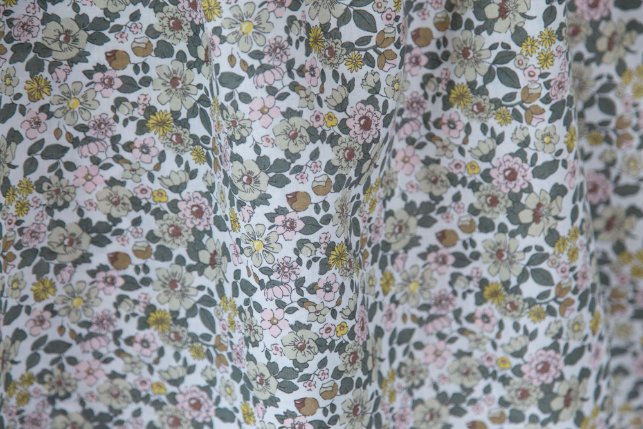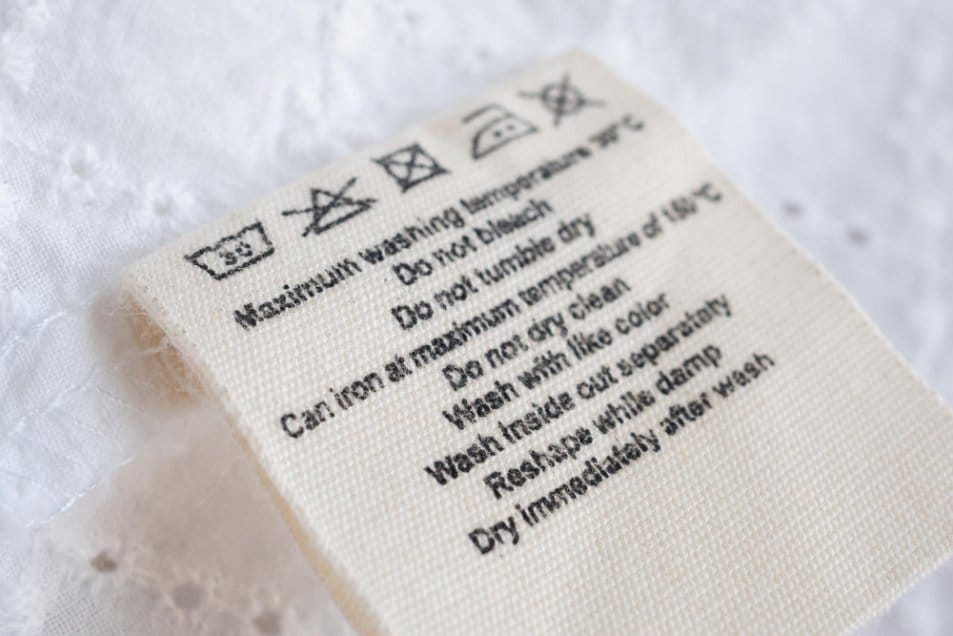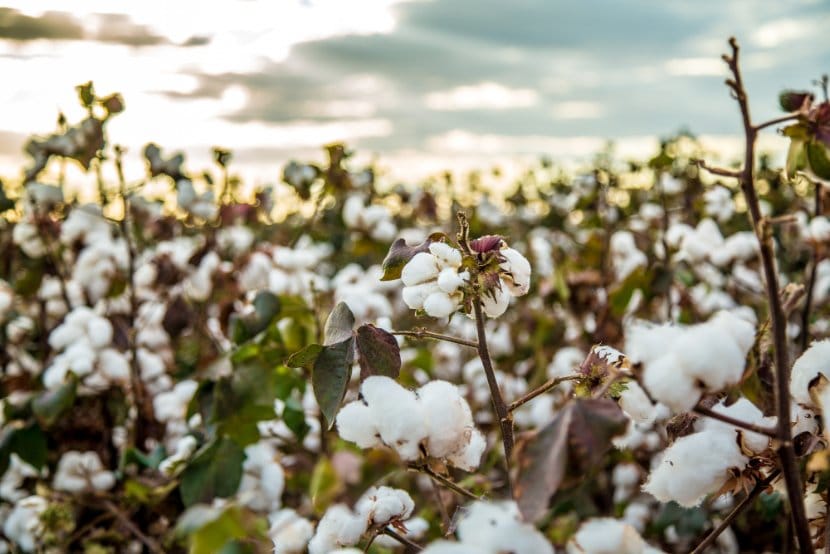From 16th-century Indian craftsmanship to modern grandmillennial style, discover everything about chintz fabric’s history, care, and contemporary uses
Table of Contents
What is Chintz Cotton?
Chintz is a glazed cotton fabric known for its shiny, polished finish and vibrant printed patterns. Originally crafted in 16th-century India, this distinctive textile gets its name from the Hindi word “chint,” meaning “spotted” or “variegated.” The fabric’s signature glossy surface comes from a special finishing process that sets it apart from regular printed cotton.
Unlike plain calico cotton, chintz undergoes a calendering process where the fabric is pressed between heated rollers to create its characteristic sheen. This glazed finish isn’t just decorative. It adds stain resistance, reduces wrinkling, and helps colors stay vibrant longer than ordinary cotton prints.
Quick Definition: Chintz is medium-weight cotton fabric with a glazed, shiny finish and bold floral or geometric patterns. It’s used primarily for home decor items like curtains, upholstery, and cushions, though it also appears in fashion garments.
What Does Chintz Mean?
The term “chintz” traces back through multiple languages. It comes from the Hindi “chīṁṭ” (meaning spotted or sprayed), which itself derives from the Sanskrit word “chitra-s” (meaning bright or clear). When European traders encountered these dazzling fabrics in India during the 1600s, they adopted the Hindi term, and it eventually became “chintz” in English.
Does Chintz Mean Cheap?
This is a common misunderstanding. The word “chintzy” developed later as British slang meaning cheap or gaudy, but authentic chintz fabric is anything but cheap. Quality chintz from established manufacturers like Lee Jofa, Scalamandre, or Colefax & Fowler can cost $50 to $200 per yard. The confusion arose when cheap British imitations flooded the market in the 1800s, leading novelist George Eliot to describe inferior fabric as “chintzy” in 1851.
The Rich History of Chintz
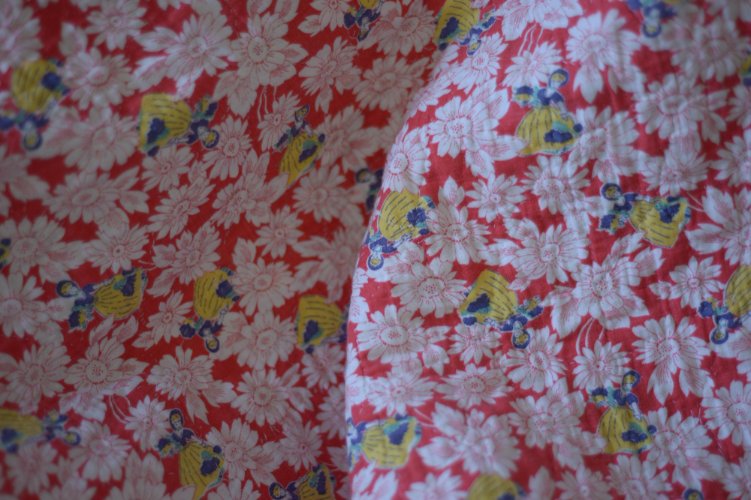
Indian Origins and Craftsmanship
Indian artisans perfected chintz production using techniques refined over centuries, as documented by the Royal Ontario Museum’s extensive chintz research. They created patterns through two main methods:
- Woodblock printing: Artisans carved intricate designs into teak wood blocks, then stamped them onto cotton using natural dyes
- Kalamkari: A 23-step hand-painting process using bamboo pens to apply mordants (chemical fixatives) and natural dyes directly onto fabric
These craftspeople used buffalo milk coatings to seal patterns and shell polishing to create the glossy finish. The process was so labor-intensive that teams of specialists worked on single pieces, with some handling dyeing while others perfected the resist techniques that prevented colors from bleeding.
Global Trade and the Chintz Craze
When Portuguese explorer Vasco da Gama reached India in 1498, he opened trade routes that would transform global commerce, as detailed in historical trade records. By the 1650s, Dutch and Portuguese traders were shipping millions of yards of Indian chintz to Europe annually. The fabric created such demand that a single ship could carry over 50,000 pieces.
European nobles were captivated by these washable, colorfast fabrics in an era when most textiles faded quickly. French courtiers reportedly traded silver weight-for-weight for the finest floral chintz. The popularity grew so intense that by 1680, over one million pieces were imported into England each year.
Trade Bans and Colonial Impact
The chintz trade became so successful it threatened European textile industries. France banned chintz imports in 1686 to protect local manufacturers. Britain followed in 1720 with the Calico Act, prohibiting “the Use and Warings in Apparel” of imported chintz and its use in household furnishings.
These bans lasted decades (France’s for 73 years), but they couldn’t stop demand. Even Versailles ignored the law, with fashionable courtiers continuing to wear chintz. The restrictions ultimately pushed Europeans to steal Indian techniques and develop mechanical printing methods, directly fueling the Industrial Revolution.
Historical Context: The East India Company eventually seized control of Indian production centers, transforming traditional workshops into colonial factories. This shift prioritized quantity over the centuries-old craftsmanship that made chintz famous, devastating India’s textile economy which had generated 25% of global wealth at its peak.
What is the Chintz Cloth That Changed the World?
Indian chintz literally changed global economics and technology, as documented in the Royal Ontario Museum’s comprehensive publication “Cloth that Changed the World.” The fabric’s popularity triggered international trade wars, sparked legislation in multiple countries, and forced Europe to industrialize textile production. The mechanical innovations developed to replicate Indian chintz techniques became foundational technologies of the Industrial Revolution, including the spinning jenny and power loom.
Characteristics and Types of Chintz
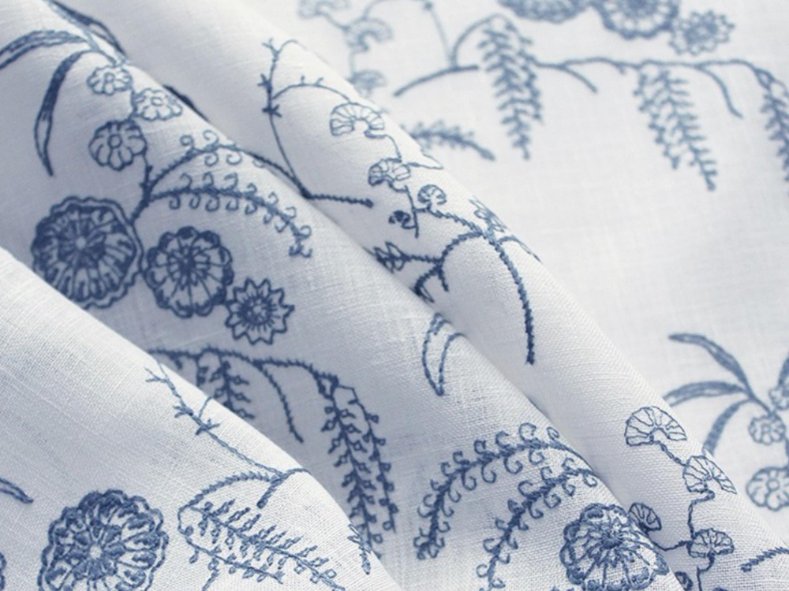
What is Chintz Made Of?
Traditional chintz is made from 100% cotton fabric, specifically using a plain weave construction with tightly twisted warp yarns and coarser, looser filling yarns. This combination creates the firm, smooth base needed for the glazing process. Modern versions might blend cotton with polyester (typically 50/50) or include small amounts of other fibers, but authentic chintz remains primarily cotton.
The Glaze: What Makes Chintz Shiny
The distinctive shine comes from glazing, applied through one of two methods:
| Glaze Type | Materials | Durability | Care Requirements |
|---|---|---|---|
| Non-permanent | Starch or wax | Wears off with washing | Dry clean only |
| Permanent (Durable) | Resin (urea or melamine) | Survives multiple washes | Can be machine washed |
Vintage chintz from the 1980s and 1990s typically has starch-based glazes that weren’t designed to survive washing. Contemporary chintz often uses resin-based permanent finishes that can handle gentler washing methods.
Is Chintz Fabric Shiny?
Yes, the glossy sheen is chintz’s defining characteristic. The shine ranges from subtle satin-like luster to high-gloss polish, depending on the calendering process and glaze type. This reflective quality enhances the printed patterns and gives chintz its luxurious appearance. However, the shine will diminish over time with use, especially on high-contact areas like chair arms.
What Are the Characteristics of Glazed Chintz Fabric?
- Weight: Medium-weight, typically 5-8 ounces per square yard
- Texture: Smooth, crisp hand feel with slight stiffness from the glaze
- Appearance: Glossy surface that reflects light
- Wrinkle resistance: Better than plain cotton due to the glazing
- Stain resistance: The glaze creates a protective barrier against spills
- Durability: Strong base fabric, though the glaze can wear in high-use areas
- Drape: Holds shape well with structured drape rather than flowing softly
Chintz vs. Related Fabrics
What is the Difference Between Chintz and Calico?
Calico is plain-woven cotton fabric, often printed with small patterns, but without any glazed finish. Think of calico as chintz’s cousin – same base material, but calico lacks the glossy coating and typically features simpler, smaller-scale prints. Historically, chintz was actually a type of calico that received the special glazing treatment.
Is Chintz the Same as Chinoiserie?
No, these are completely different concepts. Chintz is a type of fabric, while chinoiserie is a decorative art style featuring Chinese-inspired motifs like pagodas, dragons, and exotic landscapes. However, chintz fabric often features chinoiserie patterns, which can cause confusion. You can have chinoiserie patterns on fabrics that aren’t chintz, and chintz fabric with purely floral designs that aren’t chinoiserie.
What Does Cotton Sateen Look Like vs. Chintz?
Cotton sateen has a natural satin-like sheen from its weave structure (more weft threads showing on the surface), but it’s softer and has a subtle glow rather than chintz’s glossy coating. Sateen drapes more fluidly, while chintz holds its shape. Sateen’s shine is permanent and built into the weave, whereas chintz’s glaze can wear off.
What Kind of Fabric is Taffeta Compared to Chintz?
Taffeta is a crisp, smooth fabric with a slight sheen, but it’s made using a different weave (plain weave with very fine, tightly twisted yarns) and doesn’t require glazing. Taffeta produces a distinctive rustling sound when moved, which chintz doesn’t. Both have structure and body, but taffeta is typically more formal and used in eveningwear, while chintz is primarily decorative.
Chintz in Contemporary Design: The Grandmillennial Revolution
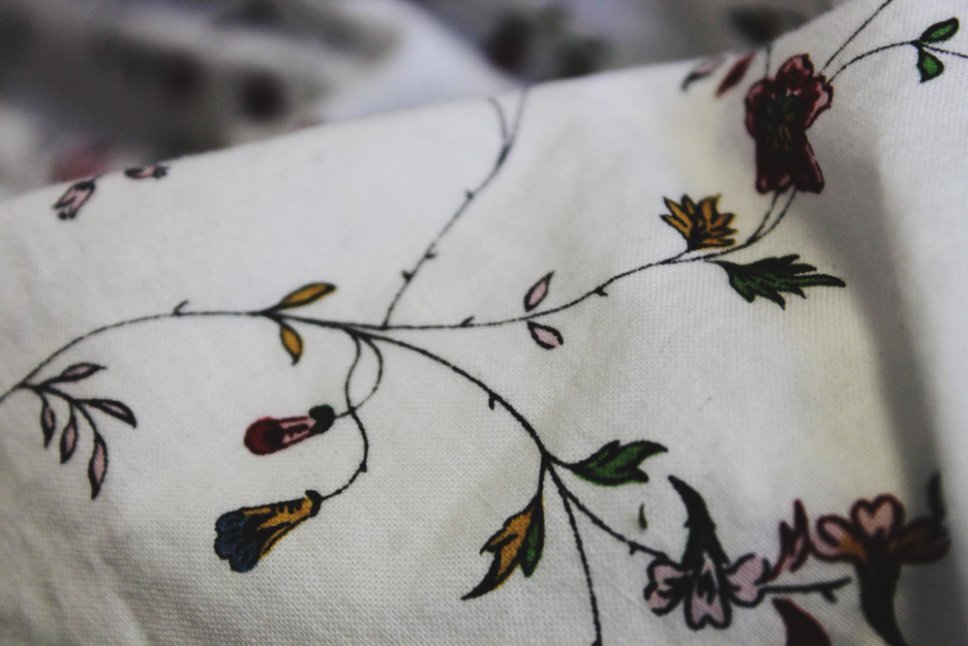
Is Chintz Back in Style?
Absolutely. Chintz is experiencing a major resurgence, driven by the grandmillennial (or “granny chic”) design movement. This trend, which gained momentum in 2019 and exploded during 2024-2025, sees millennials and Gen Z embracing traditional patterns their grandparents loved, but with fresh, modern twists.
According to Zillow’s 2024 home trend analysis, nostalgic design elements including chintz appeared in 14% more real estate listings than the previous year, while “vintage” mentions increased by 9%. The trend represents a backlash against years of stark minimalism and all-white interiors.
Why Grandmillennial Style Loves Chintz
Interior designers report clients in their 20s and 30s specifically requesting chintz, treillage, and bold floral patterns. Dallas-based designer Amy Berry notes: “After watching everybody do neutral, transitional rooms for so long, we’ve had several younger clients come to us asking for chintz and bright colors, and I’m thrilled about it.”
The appeal lies in creating spaces that feel personal and collected rather than staged. Grandmillennial style values warmth, pattern-mixing, and pieces with stories, making chintz’s historical richness and visual impact perfect for the aesthetic.
How to Use Chintz in Modern Interiors
Today’s designers avoid the matchy-matchy chintz rooms of the 1980s. Instead, they use these techniques:
- Mix scales: Combine large-scale chintz florals with smaller geometric prints or stripes
- Balance with modern pieces: Pair a chintz wingback chair with a sleek metal side table
- Limit the pattern: Use chintz as an accent (curtains or a single chair) rather than covering every surface
- Update the color palette: Choose chintz in contemporary colors like navy, charcoal, or dusty rose instead of traditional pastels
- Layer textures: Combine chintz with velvet, linen, and leather for depth
Designer Tip: The key to making chintz feel current is confidence. Don’t apologize for the pattern by hiding it. Let one bold piece shine, then build around it with complementary solids and smaller-scale patterns.
Is Chintz Fabric Still Popular?
Beyond the grandmillennial trend, chintz maintains steady popularity in traditional and English country house design. Brands like Colefax & Fowler, Lee Jofa, and Scalamandre continue producing new chintz patterns because demand remains strong from interior designers working on classic interiors. The fabric never really left high-end decorating; it simply moved in and out of mainstream attention.
How to Care for Chintz Fabric
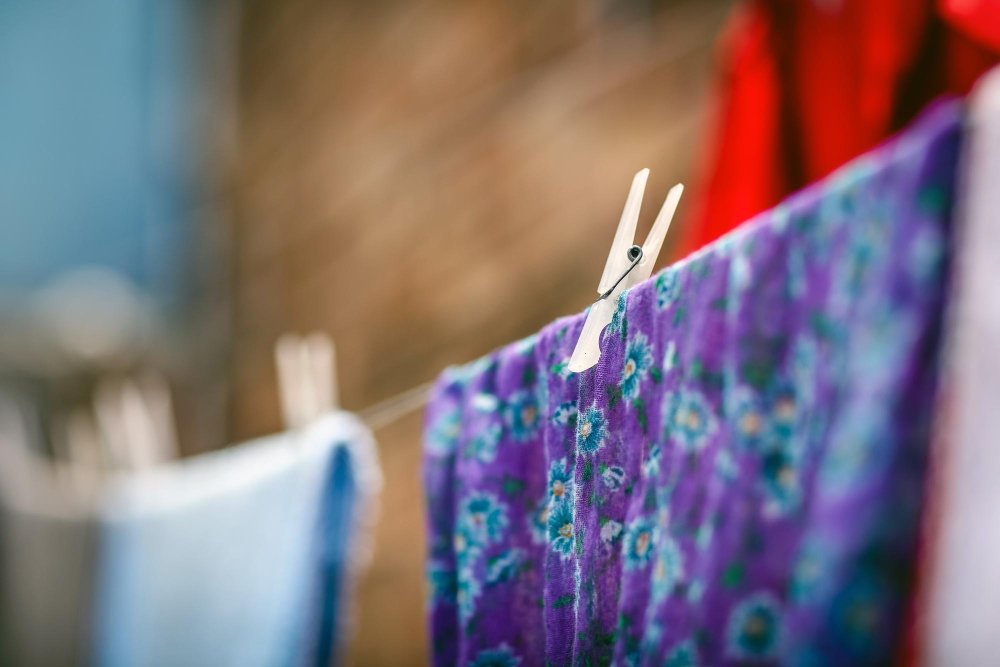
Can Chintz Be Washed? Is Chintz Washable?
The answer depends entirely on which type of glaze your chintz has. This is the most critical thing to understand about chintz care:
- Non-permanent glaze (starch/wax): Cannot be washed. Dry clean only, and even dry cleaning may remove some glaze
- Permanent glaze (resin): Can be gently machine washed or hand washed
The problem is that you often can’t tell which type you have just by looking. Always check the manufacturer’s care label. If there’s no label or you’re working with vintage chintz, assume it has a non-permanent finish and avoid water.
Cleaning Chintz Upholstery
Dry Cleaning Method (Safest for Most Chintz)
- Use a dry-cleaning sponge (available at hardware stores) to gently wipe the surface
- Work in small circular motions, letting the sponge lift dirt from the glaze
- For stubborn spots, use a barely damp cloth with minimal moisture
- Immediately follow with a dry cloth to remove any dampness
- Allow to air dry completely before using the furniture
When the Glaze Has Worn Off
On chair arms or headrests where the glaze has rubbed away from heavy use, you can carefully spot clean the unglazed areas with water-based cleaners. Use a targeted approach like a Bissell Little Green machine, applying cleaner only to the worn spots while avoiding intact glazed areas.
Washing Chintz Drapery and Textiles
For permanently glazed chintz that’s labeled machine-washable:
- Wash in cold or warm water (never hot)
- Use gentle cycle with mild detergent
- Never use bleach or harsh chemicals
- Remove from washer while still slightly damp
- Line dry or tumble dry on low heat only
- Iron on reverse side (wrong side of fabric) with medium heat
Warning: Even permanent glazes can dull over time with repeated washing. Consider professional cleaning for valuable or antique pieces.
Caring for Chintz Garments
Chintz appears in vintage clothing, particularly blouses and skirts from the 1940s-1980s. For apparel:
- Hand wash in cool water is safest
- Use detergent designed for delicate fabrics
- Never wring or twist; gently press out excess water
- Lay flat or hang to dry away from direct heat
- Iron while slightly damp on reverse side
- Use steam carefully, as too much moisture can affect the glaze
Maintaining the Shine
The glazed finish naturally wears with use, but you can extend its life:
- Keep chintz out of direct sunlight, which degrades both colors and glaze
- Vacuum upholstered pieces weekly with soft brush attachment
- Rotate cushions and pillows to distribute wear evenly
- Store unused chintz items in breathable canvas bags, not plastic
- Apply fabric protector spray after cleaning (test first on hidden area)
Stain Removal Tips
Always test any cleaning method on an inconspicuous area first.
- Blot (never rub) fresh spills immediately with clean white cloth
- For water-based stains, use minimal moisture with mild soap
- For oil-based stains, dry cleaning solvent works best
- Apply stain remover to cloth, not directly to chintz
- Work from outside of stain toward center to avoid spreading
- Allow to air dry; check if stain remains before applying heat
Is Chintz Waterproof?
No, chintz is not waterproof. The glaze provides some water resistance, causing spills to bead up initially rather than immediately soaking in, but it’s not a waterproof coating. This brief water resistance gives you time to blot spills before they set, but chintz will absorb moisture if left wet. Never use chintz in bathrooms or other high-humidity areas.
Buying Guide: What to Look For in Quality Chintz
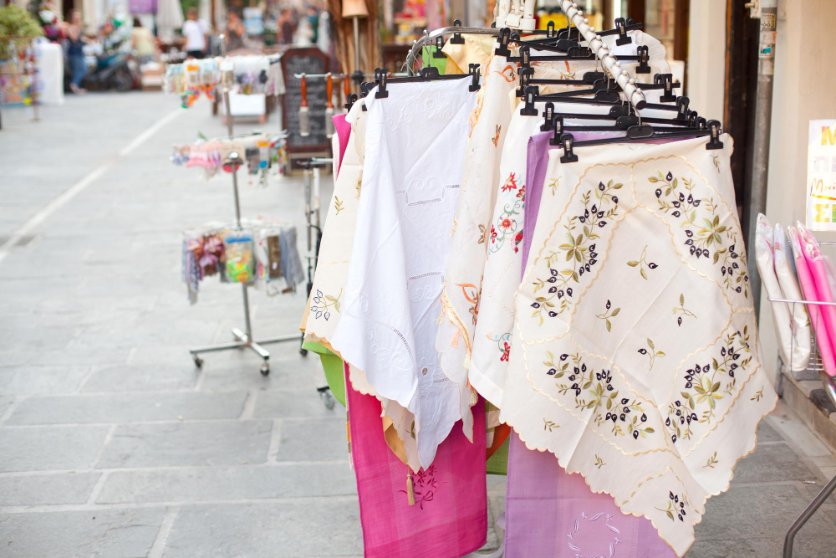
Quality Indicators
Not all chintz is created equal. Here’s how to spot quality fabric:
- Even glaze application: The shine should be consistent across the entire surface without streaks or dull patches
- Tight weave: Hold fabric up to light; you shouldn’t see much light through quality chintz
- Crisp hand: Good chintz feels substantial, not limp or flimsy
- Sharp print registration: Patterns should align perfectly with no blurring or off-register colors
- Colorfastness: Rub white paper on the fabric; quality chintz shouldn’t transfer dye
- Selvage markings: Designer chintz will have manufacturer information woven into the selvage edge
Understanding Price Ranges
| Price Point | Cost Per Yard | What to Expect | Best For |
|---|---|---|---|
| Budget | $10-$25 | Basic prints, may have non-permanent glaze, limited durability | DIY projects, test pieces |
| Mid-Range | $25-$60 | Better quality cotton, decent patterns, more durable glaze | Curtains, cushions, moderate-use upholstery |
| Designer | $60-$150+ | Luxury manufacturers, exclusive patterns, permanent glaze, excellent durability | Investment furniture, period-accurate restorations |
Where to Buy Chintz Fabric
Quality sources include:
- Specialty fabric stores: Chintz & Company, Mood Fabrics, online decorator fabric retailers
- Designer showrooms: Lee Jofa, Scalamandre, Colefax & Fowler, Brunschwig & Fils (usually to-the-trade only)
- Online marketplaces: Etsy for vintage chintz, Spoonflower for custom prints
- Discount sources: Designer fabric outlet stores, online clearance sites
Questions to Ask Sellers
Before purchasing, clarify these points:
- Is the glaze permanent or temporary?
- What are the recommended care instructions?
- What’s the fiber content? (100% cotton vs. blends)
- What’s the fabric width? (45″, 54″, 60″)
- Is this suitable for upholstery, or decorative use only?
- Can I order a swatch before buying yardage?
- What’s the pattern repeat size?
Pro Tip: Always order swatches before committing to full yardage, especially for online purchases. Colors appear differently in person, and you need to feel the weight and see the glaze quality before investing in a large project.
How Much Chintz Do You Need?
Calculate yardage carefully, considering pattern repeats:
- Throw pillows: 1/2 to 1 yard (depending on size)
- Dining chair seat: 1 to 1.5 yards per chair
- Wingback chair: 8 to 12 yards
- Sofa: 12 to 18 yards
- Curtain panels (per pair): 2 to 6 yards (depends on window height and fullness)
Add 10-15% extra for pattern matching and cutting errors, especially with large-scale designs.
Sustainability and Ethical Production
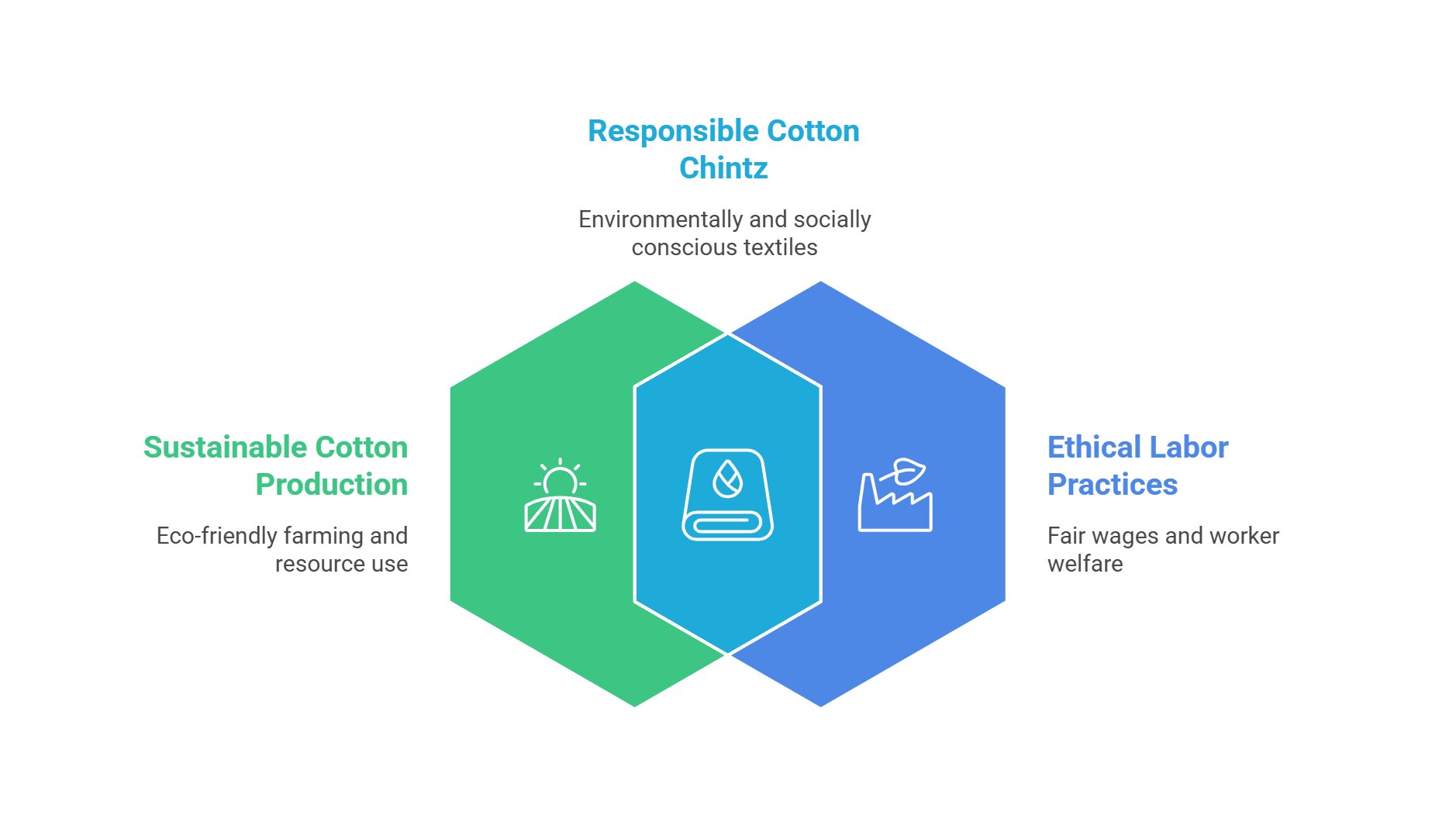
Is Chintz Sustainable?
The sustainability of chintz depends on how it’s produced. Traditional chintz has both sustainable and problematic aspects:
Sustainable Aspects
- Natural base material: Organic cotton chintz uses renewable plant fibers
- Durability: Quality chintz lasts decades with proper care, reducing replacement needs
- Traditional dyeing methods: Some artisan producers still use natural, plant-based dyes
- Heritage craft preservation: Supporting traditional chintz maintains centuries-old skills
Environmental Concerns
- Conventional cotton farming: Uses significant water and pesticides unless organic
- Chemical glazes: Resin finishes may contain formaldehyde or other chemicals
- Synthetic dyes: Most modern chintz uses petroleum-based dyes
- Water usage: The dyeing and finishing processes consume large amounts of water
Ethical Production and Modern Artisans
Several brands are reviving traditional chintz production with ethical practices:
- Anokhi: Indian company using hand-block printing and natural dyes, supporting fair-wage artisans
- Block Shop: Works with family-run workshops in Jaipur, preserving traditional techniques
- Urban Chintz: UK designer brand using digital printing to reduce dye waste and offering zero-waste production
These companies prioritize artisan welfare, use eco-friendly dyes where possible, and maintain transparent supply chains. When buying new chintz, look for certifications like GOTS (Global Organic Textile Standard) or OEKO-TEX Standard 100, which ensure organic fibers and limited harmful substances.
The Sustainable Choice: Vintage Chintz
Buying vintage or secondhand chintz might be the most sustainable option. It gives existing fabric new life, avoids new production impacts, and often provides access to quality that’s hard to find in modern manufacturing. Check estate sales, antique shops, and online vintage textile dealers for authentic pieces.
Is Cotton Ethically Made?
This depends entirely on the source. Conventional cotton production faces serious ethical issues, including water depletion in growing regions, pesticide exposure for farmworkers, and exploitative labor practices in some countries. However, organic and fair-trade certified cotton addresses these concerns through regulated farming practices and guaranteed fair wages.
Modern Applications and Uses
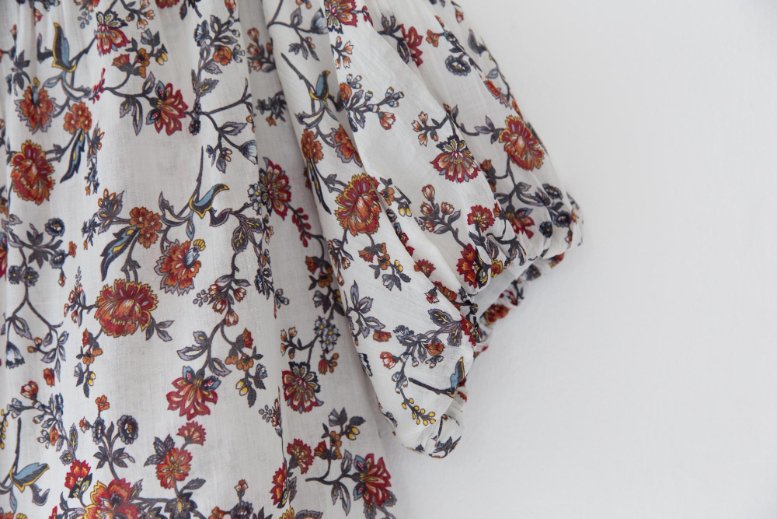
Home Decor Applications
Chintz excels in various home furnishing projects:
Upholstery
Chintz works beautifully for furniture that doesn’t receive heavy daily use. The glazed surface resists light staining and dust, making it practical for dining chairs, occasional chairs, and headboards. Avoid using it on sofas in high-traffic family rooms where the glaze will wear quickly.
Window Treatments
Curtains and drapery are chintz’s natural habitat. The fabric’s body helps curtains hang well with defined pleats, and the glaze adds subtle light reflection. Always line chintz curtains to protect from sun damage and extend their life.
Decorative Accents
Chintz shines in throw pillows, cushions, table runners, and lampshades. These smaller projects let you enjoy the pattern without overwhelming a room and are easy to change seasonally.
Fashion and Accessories
While less common today, chintz appears in:
- Vintage-inspired dresses: Full skirts and fitted bodices showcase the fabric’s structure
- Blouses and shirts: The crisp hand creates tailored silhouettes
- Accessories: Bags, headbands, and hair scrunchies gain interest from the glossy finish
When sewing with chintz, use sharp needles and avoid excessive pinning, which can leave permanent marks in the glaze.
Quilting and Crafts
Quilters sometimes use chintz for special projects, though it’s trickier than regular quilting cotton. The glaze can make needle-turn appliqué difficult, and the fabric’s crispness doesn’t soften as much with washing. Pre-washing may remove glaze on non-permanent finishes, so test first.
Frequently Asked Questions
Pure cotton fabric breathes well, absorbs moisture, feels soft against skin, and improves with age. Unlike synthetic blends, 100% cotton doesn’t trap heat or static, making it comfortable year-round. It’s also hypoallergenic and biodegradable, though it does wrinkle more easily than polyester blends.
These terms mean the same thing. Both indicate the fabric contains only cotton fibers with no synthetic or other natural fiber blends. Some manufacturers use “pure cotton” for marketing appeal, but legally and practically, it’s identical to “100% cotton.”
When a label just says “cotton,” it might be a blend containing other fibers (polyester, rayon, spandex). The fabric must be majority cotton to use the term, but could be as little as 60% cotton. “100% cotton” guarantees no other fibers are present. For chintz specifically, traditional versions are always 100% cotton, though modern versions may blend in synthetic fibers.
The cotton base is very durable, but the glazed finish has limitations. With proper care, quality chintz can last 15-20 years or more in moderate-use applications like curtains and decorative chairs. However, high-contact areas (sofa arms, seat cushions) will show wear faster as the glaze rubs away. The underlying fabric remains strong even after the glaze wears off.
In British slang, “chintzy” means cheap, gaudy, or of poor quality. Interestingly, this meaning developed as an insult toward cheap imitation chintz that flooded British markets after the original Indian imports were banned. The word took on negative connotations that don’t apply to authentic, quality chintz fabric.
Chintz isn’t a color—it’s a type of fabric that comes in countless colors and patterns. Traditionally, chintz featured bright floral designs on light backgrounds (white, cream, pale yellow). Classic color combinations include pink roses on white, blue and white botanical prints, or multicolored garden scenes. Contemporary chintz appears in modern palettes including navy, charcoal, emerald green, and even black backgrounds.
Terms that relate to chintz include “glazed cotton,” “polished cotton,” and “calico” (though calico technically lacks the glaze). In historical contexts, “printed cotton” or “painted cotton” referred to similar fabrics. However, true chintz is distinctive enough that exact synonyms don’t really capture its unique glazed, printed character.
Yes, especially Indian chintz in 17th-century Europe. The vibrant, washable colors and intricate patterns were revolutionary compared to European textiles of the era. Wealthy nobles paid premium prices, and chintz became a status symbol. The fabric’s luxury status triggered trade restrictions because European manufacturers couldn’t compete. Even after mechanization made cotton more accessible, fine chintz remained expensive.
Initially, British consumers used imported Indian chintz for home furnishings (bed hangings, curtains, wall coverings) and fashionable clothing. After Britain developed its own cotton industry during the Industrial Revolution, cotton became the foundation of everyday clothing, workwear, and household textiles. The cotton trade shaped British economic policy and colonial expansion for centuries.
With protectionism and eventual industrial theft. France banned chintz imports in 1686, Britain in 1720, and Spain in 1717. These restrictions lasted decades but couldn’t stop demand. European traders sent spies to India to learn production secrets, eventually replicating the techniques mechanically. The race to copy Indian chintz directly drove textile innovations that powered the Industrial Revolution.
No, muslin remains widely available today as a lightweight, plain-weave cotton fabric. It’s extensively used in fashion design for making test garments (toiles), in cooking as cheesecloth, and in theater for backdrops. While the finest quality muslins from historical India are no longer produced at the same scale, modern muslin serves many practical purposes.
Technical Specifications and Comparisons
Fabric Weight and Specifications
| Specification | Typical Range | Best Use |
|---|---|---|
| Weight | 5-8 oz per square yard | Medium-weight for versatile applications |
| Width | 45″-54″ (sometimes 60″) | Standard width accommodates most projects |
| Thread Count | 150-250 | Dense enough for glaze adhesion |
| Durability Rating | 15,000-25,000 double rubs | Light to medium upholstery use |
Chintz vs. Other Cotton Fabrics
| Fabric | Key Difference | Similar Qualities |
|---|---|---|
| Calico | No glazed finish, usually smaller prints | Plain weave, printed cotton base |
| Poplin | Finer weave, no prints or glaze | Crisp hand, holds shape well |
| Sateen | Sheen from weave, not glaze; softer drape | Lustrous appearance |
| Voile | Sheer, lightweight, no glaze | Plain weave structure |
| Broadcloth | Solid colors, tighter weave, matte finish | Medium weight, plain weave |
Styling and Design Ideas
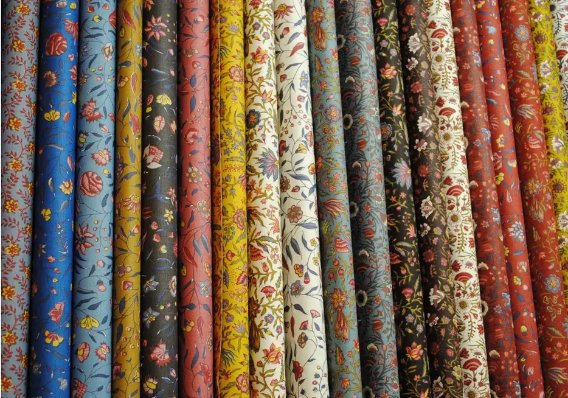
Color Coordination with Chintz
Chintz patterns often contain multiple colors, making coordination easier than expected. Pull accent colors from the print rather than trying to match the background exactly:
- With traditional floral chintz: Pair with solid linens in cream, sage green, or soft blue
- With modern geometric chintz: Combine with bold solids in colors that appear in the pattern
- With vintage chintz: Mix with brass fixtures and warm wood tones for collected English country style
Pattern Mixing Guide
Chintz plays well with other patterns when you follow basic design principles:
- Vary scale: Pair large-scale chintz florals with small-scale checks or pin dots
- Limit color palette: Keep coordinating patterns within 3-4 main colors
- Use a neutral anchor: Balance busy patterns with solid neutrals
- Mix pattern types: Combine florals with stripes, geometrics, or animal prints
Shopping Resources and Tools
Before purchasing chintz for your project, use these helpful tools to ensure you get exactly what you need:
- Fabric Yardage Calculator – Calculate exact fabric requirements for your project
- Cotton Type Selector Quiz – Find your perfect cotton fabric match
- Fabric Care Generator – Get personalized care instructions
Conclusion
Chintz cotton represents more than just decorative fabric. It embodies centuries of craftsmanship, global trade history, and design evolution. From its origins in 16th-century India through its role in sparking the Industrial Revolution to its current revival in grandmillennial interiors, chintz has proven its lasting appeal.
Key Takeaways
What You Need to Remember About Chintz
- Identify your glaze type before cleaning: This single factor determines whether you can wash your chintz or must dry clean it. When in doubt, assume non-permanent glaze and avoid water.
- Quality matters significantly: Invest in good chintz for upholstery and high-visibility applications. Budget options work fine for temporary projects or crafts where longevity isn’t critical.
- Chintz is having a genuine renaissance: The grandmillennial trend has brought this historic fabric back into mainstream decorating, especially among younger homeowners seeking warmth and personality.
- Protection extends life dramatically: Keep chintz away from direct sunlight, apply fabric protector, and address stains immediately to preserve both colors and glaze for decades.
- Scale and balance prevent dated looks: Use chintz boldly but thoughtfully, mixing it with modern pieces and varying pattern scales to avoid the overly matchy 1980s aesthetic.
Final Recommendations
If you’re new to chintz, start small. Order swatches from multiple suppliers to compare quality, patterns, and glazes in person. Test with a single throw pillow or small upholstery project before committing to curtains or furniture. This lets you understand the fabric’s characteristics and care requirements without major investment.
For those embracing grandmillennial style, remember that confidence is key. Chintz commands attention, so place it where it can shine as a focal point rather than trying to hide it. One spectacular chintz piece in a room makes a stronger statement than multiple competing patterns.
Consider the complete lifecycle when choosing chintz. Vintage pieces offer immediate character and proven durability, while new fabric from ethical producers supports traditional crafts and sustainable practices. Either choice brings this remarkable textile’s rich history into your home.
Whether you’re drawn to chintz for its historical significance, its practical benefits, or simply its visual impact, this glazed cotton fabric offers something unique in today’s world of mass-produced textiles. It connects us to centuries of craftsmanship while remaining perfectly suited to contemporary living.
Next Steps
Ready to start your chintz project? Here’s what to do:
- Determine your application (upholstery, curtains, pillows, garments)
- Order swatches from 2-3 suppliers to compare quality and patterns
- Calculate yardage needs with 10-15% extra for pattern matching
- Verify glaze type and care requirements before purchasing
- Plan your room design to balance chintz with complementary solids and textures
- Source proper sewing supplies if making items yourself
With proper selection, care, and styling, chintz cotton can bring timeless elegance and personal character to your home or wardrobe for years to come.

